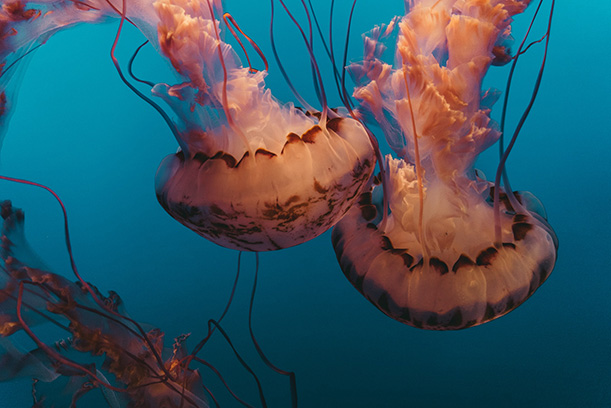BOOMbox at Home: Ocean Activities
June 10, 2020

This week, we’re exploring ocean ecosystems in honor of World Oceans Day, which was June 8. Looking from above water, or standing on the beach, you only see a fraction of the life that calls the ocean its home. Let's learn more about the relationships of the organisms that live underwater.
Layers of Ocean Life
Did you know that the ocean holds more than 1.3 billion cubic km of water? It’s no surprise that such a massive space contains a range of living environments. You can use the surface tension of different liquids like water and dish soap to model the five major layers of the ocean by following this DIY ocean layers tutorial from Learning Resources. Once you’ve learned a bit about the different characteristics of the zones or layers, dive into this interactive deep sea model by Neal Agarwal to see what kinds of creatures live at each level.
Ocean Organisms
Want to learn more about the animals of the ocean? Browse Oceana’s Marine Life Encyclopedia for beautiful photos and fun facts about all sorts of organisms, from laughing gulls to harbor seals to striped pyjama squids and more. Or, have a taste of life in the Antarctic Ocean with Krill Smackdown, a game from National Geographic Kids where you control a group of krill that are trying to escape being eaten.
Underwater Expeditions
The ocean is full of mystery, and we have a lot left to explore. You can see where sharks, dolphins, seals, and more are today with this tracker from Ocearch. If you click on a recent ping, you can follow your favorites with a map showing their travels since they were first tracked.
You can tag along on research expeditions from the comfort of your home with Dive and Discover from the Woods Hole Oceanographic Institution. The site documents 16 different expeditions, with daily updates from the crew, photos, videos, interviews, and more. There are also opportunities to learn more about specific topics with interactive Deeper Discovery models. Not sure where to start? See one of our favorite expeditions, which follows a team researching life in one of the most extreme environments our planet has to offer: deep-sea hydrothermal vents.
Further Reading
If you’d like to learn more about the ocean, make sure to check out World Oceans Day to see how you can help protect our oceans. If you’re curious about why conservation is so important, take a look at this introduction to all things shark from the Smithsonian Institution to see more about why sharks are so awesome and how unsustainable practices put them (and the entire ocean ecosystem) at risk.
Scientist of the Week
Hozoji Matheson-Margullis is a marine biologist working to conserve the ecosystem of the Puget Sound. She uses the indigenous STEM knowledge of her tribe, the Pullayup, to study the environmental impact of climate change on shellfish, diving to collect samples of geoducks, which are saltwater clams. The marine life she saw while working as a commercial shellfish diver inspired her to work in conservation and pursue a degree in marine biology. Matheson-Margullis is also a well-reknowned drummer who tours with her band, Helms Alee.
Share
We’d love to see the results of your experiments! Tag @skokielibrary when you share photos of what you’ve created on social media.
This week's post was written by Eli and Frannie.